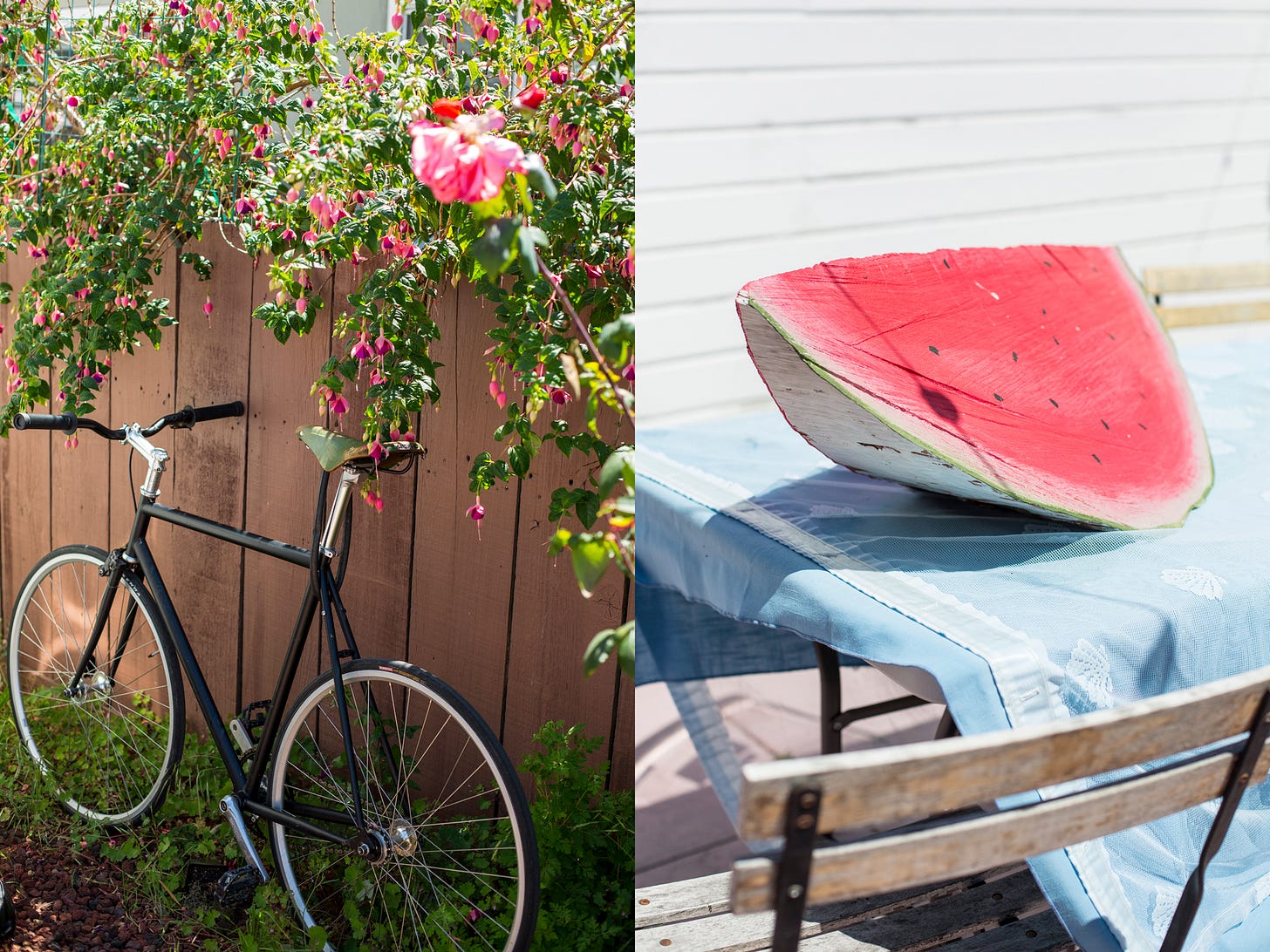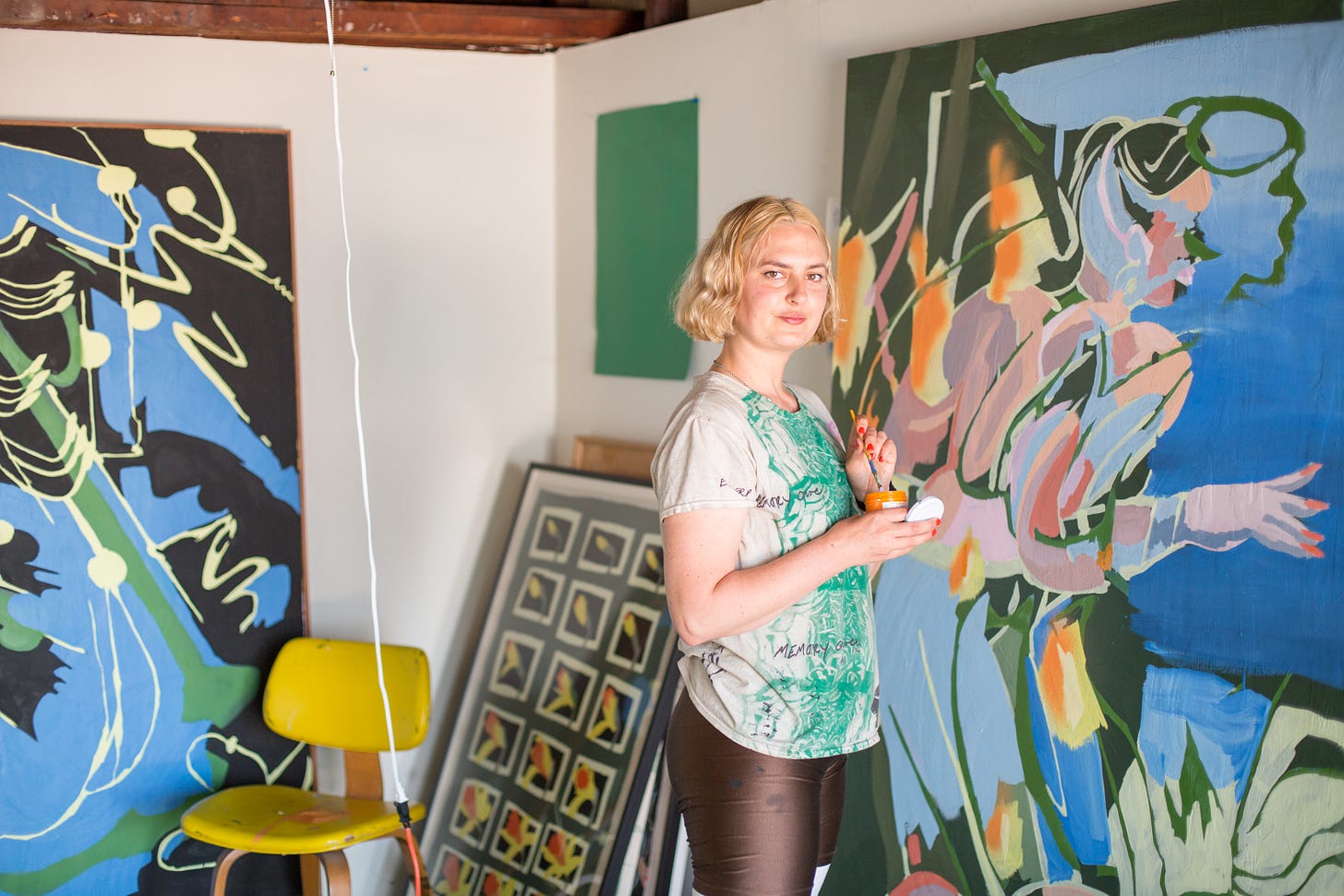At home in Albany, California with Lena Gustafson
"Over the years our taste and interests have changed but we have this crumb-trail of zines that archive the last decade." - Lena Gustafson
Good morning,
I recently visited the home of artist Lena Gustafson in Albany, a small town near Berkeley, California. I love how the female figures in Lena’s paintings are embodied—rather than languid—how their epic, active, limbs stretch, play, groom, meander, domesticate, and fill the paintings to their teeming brim, without apology, timidity, or affect. Lena’s graphic, plush paintings convey a visually layered world that is ripe with slightly chaotic color palettes that I adore. I wasn’t disappointed when I found the same sort of aesthetic: layered, loose, vivid, exuberant, embodied in Lena’s home space.
Her home realm, like the realm in Lena’s painted world, is full of welcoming, tangible pleasures. It is a juicy, tactile space rich with prints, drawings, sculpture, zines and velvet; hues and textures from a life infused with projects, partnerships and a plethora of collaborative possibilities. Lena collects and cares for a collection of zines and printed ephemera (many of which she has published as part of Night Diver Press in collaboration with her partner, Peter Calderwood). Likewise, she also, at least in my eyes, cares for the careers of artists in her community by featuring their work in her own publication, Practice.
In fact, the collective, and its the-more-the-merrier tone of communal experimentation is a thread that runs through her home. From the oversized, wooden watermelon sculpture she made with Peter, that sits, all-seasons, tempting yet inedible, on a courtyard table, to the stacks of unique artist books tucked away into a flat-file which doubles as a coffee-table in their living room, to the oversized shell sculpture painted in fantasy neons and toned down neutrals, far from the seashore, to a completely sunshine-hued bed, playful, unabashed references of real things made larger than life exist in every room of Lena’s home; even in the bathroom, an oversized comb perches on the edge of a framed painting. Throughout, there is a sense of ease, interactivity, and imagination which can’t be, should never be, corked.
Hi Lena! What’s your home-aesthetic in 3 phrases?
Sensory deprivation with moments of specific simulations. Warm, come over. An archive of life with art.

Do you and your partner Peter collect anything in particular at home?
The only real thing we collect is our friends' art and zines. It’s the most important thing to me about our home. When Pete and I met over ten years ago we started collaborating on screen printed art books. Through collaborating with each other we formed a love for print and all its many forms. Over the years our taste and interests have changed but we have this crumb-trail of zines that archive the last decade. What I love most about art books and zines is the way they can help break me out of limiting social bubbles, and help expand my way of seeing the world.
Tell me how one of your life philosophies is reflected within your home.
Collective thinking is more important than individual gains. I like to surround myself with my art-community’s work to remind myself of the many brilliant creative people around me.
What’s the best advice you ever received on how to cohabitate with another person?
Make sure you like the person you are living with.

Do you have a favorite piece of art at home?
I don’t have a favorite piece of art, but one piece that truly blows my mind is this print titled “For Edmonia” by Yétundé Olagbaju published by Sun Night Editions. It is a 5 Color Screen Print with unique Van Dyk embellishments. What I love most about it is the collaboration between the publisher and artist to come up with something truly original and new for both parties—a combination of exceptional printing techniques and conceptual brilliance from the artist.
How do you decide what objects to live with?
Slowly. The nice thing about living in a small, one-bedroom is that there’s limited space to fill. After moving out of our last place which was a live/work warehouse, we both wanted to live with less. That warehouse was our screen printing studio, painting studio, and living space for seven years. It was great for the time, but it is so refreshing to have some separation between art making and life. Now our home is smaller and filled with things we love.
In finding or choosing an architectural space to inhabit, what are the most important factors for you?
To be honest, rent is probably the most important factor in choosing a space to inhabit. It is a unique challenge to try to find a space to live in and still be able to afford some sort of studio on top of that. But beyond rent, the two main things I look for in a new space is a window behind the kitchen sink and a bathtub.
What’s your most beloved object at home? How did it enter your life, and how would you say it affects you?
Definitely the flat file my Grandma Mary gave to us when Pete and I helped her move last year. She has always loved typography, prints, art, and stationary. She also has always kept her belongings in such pristine condition—something I aspire to. I love the wooden flat file with gold handles—and a glass top that we rotate different prints under so much. It’s where we store all of our zine/print collections. It’s also where we play dominos or have a cocktail.
Would you rather be a guest or a host?
I like being both but I’ll say host. I think because I am an introvert I feel like I can represent myself to people in a fuller way when I have new friends over.
Do you have any tips on how to live well in your home space? Or do you have other offerings for fellow home-dwellers seeking to live resourcefully and creatively?
Hang your walls with living artists! If you can’t afford original works, there are many options for more affordable works: Tiny Splendor and Sun Night Editions are a couple of great resources for this.
What routines do you have in place in regards to painting from your home-studio that've been most beneficial?
A big one, which seems simple, is to put sound canceling headphones on at the beginning of a studio workday, and keep them on until I am finished. It helps me focus and not get concerned or curious about other sounds from my neighbors, or cars going by. I sometimes have a difficult time sinking into myself and my inner world, and wearing big headphones helps let me define this creative time.
Describe your home in 5 words.
Warm, loved, uncluttered, small, safe.
Describe your dream home in 5 words.
Warm, loved, uncluttered, spacious, bright.
Delving Deeper:
Find out more about Night Diver Press, a small print publishing studio founded by Lena and her partner Pete Calderwood. NDP works with visual artists to develop original works—translated mostly via screenprint and risograph—into printed editions and books. There’s also Lena’s magazine, Practice, wherein she interviews an expansive network of artist friends (as well as photographs them on film) about their unique studio practices.
Some of the striking art in Lena’s home comes from Creativity Explored and Creative Growth. Both are established Bay Area organizations supporting artists with developmental, physical and intellectual disabilities to produce work and develop one-of-a-kind exhibitions. Some of my favorite, and incredibly affordable, artworks over the years have come from their (respective) online shops.
Etymology Interlude:
collective kuh·lek·tuhv (adjective)
From the early 15th Century, Old French collectif, meaning ‘comprehensive’ or ‘a whole consisting of a plurality of individuals.’
Collectivus is the Latin origin of collectif, and derives from the root word ‘collectus’, the past participle of colligere, from com (together) and legere (to gather), meaning "gather together."
Thinking, and seeing—as a collective—has the effect of a expertly executed collage. A collage is not always on paper, it can be in a three dimensional interior, or in a commingled, community vision. It can coalesce and unite disparate parts into a shared whole. If an aesthetic can be said to convey, or be rooted in, an ethos, I’d argue that Lena’s visual style promotes the effervescent kind of joy that comes from positively aligned, collective vision.
Consider Home…
A space for the collective, whatever that looks like to you. Home can be, and I would go so far to say, should be, a space able to support a larger network of some sort, be it a community of friends, a book club, a burgeoning lecture series, cooking classes; a collection of seedlings; elders or babes; foreign exchange students or foster pets. A house, or any dwelling that serves as a home, becomes most itself when it’s shared.
My recommendations this month: firstly, a pitch-perfect, complex and hilarious six-part HBO series called The White Lotus, where the interrelationships of a group are articulated in a comic, tragic, honest and embellished fashion, in a hotel, a home away from home. Commentaries on tourism, desire, order, marriage, locals, race, power, capitalism, it’s just so keenly done. I also love how it maps out how individuals cannot exist in bubbles, but rather how we affect everyone in our radar, be they strangers or intimates, with our own idiosyncrasies. I laughed out loud just as much as I felt real compassion for these layered characters, amidst moments of brutal realism and sardonic humor.
Secondly, this episode of The Ezra Klein show, about the wonder of the shared animal world—of which we are a part—in particular, octopuses, who essentially have nine brains. Imagine that—a multiplicity of minds “corporealized” in the form of tentacles, each able to make unique decisions (even after being cut off from the whole body the tentacles have minds of their own and can function for a stint, despite being disembodied). The octopus, with it’s de-centralized self, and instead, with its collective intelligence, reminds me of Lena’s declaration: collective thinking is more important than individual gains.
This has never felt more true to me in this summer of drought, smoke, heat, floods, and mass migrations of human and non-human animals. The increasingly clear repercussions of climate change are seeping into our home here on our collective abode, our planet. Might our individual experience of, longing for, or tending to, home, promote collective thinking? How can we put our auto-pilot appetites for individual gains on the back-burner so we can more readily cook up something nourishing for the hungry whole? How might understanding the values of having a home affect how we care for, truly tend to, this broader place we are dependent upon? Home, sweet home is sadly, not a given.
Until next time,
Airyka











